Scottish Health Survey 2016 - volume 1: main report
Statistics relating to the health of people living in Scotland.
This document is part of a collection
5 Obesity
Diana Bardsley
Summary

These figures are largely unchanged since 2008.
- Men were significantly more likely than women to be overweight including obese in 2016 (68% compared with 61%) as in all survey years since 2003.
- Obesity prevalence was highest among those aged 65- 74 (36%) and lowest among those aged 16-24 (14%).
The mean BMI has increased from 27.1 to 27.7 since 2003
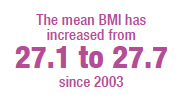
- 70% of children (aged 2-15) were of healthy weight in 2016, which is in line with figures since 1998 (between 65% and 72%).
- At 29%, the proportion of children at risk of being overweight (including obesity) in 2016 was similar to previous years.
- There has been a significant decline in the prevalence of the risk of obesity in children between 2014 (17%) and 2016 (14%), representing a return to the lowest recorded rate of 14% in 1998.
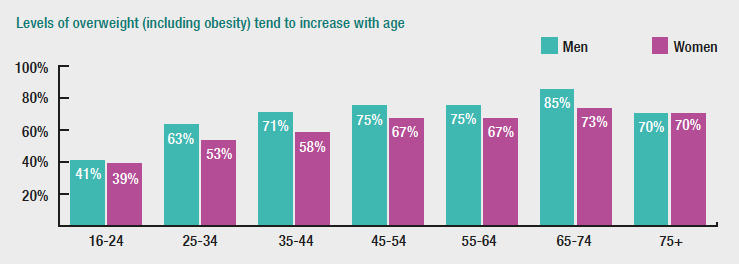
5.1 Introduction
Overweight and obesity have been defined as abnormal or excessive fat accumulation that may impair health[1,2]. Obesity is associated with an increased risk of a number of common causes of disease and, at high levels of obesity (BMI of 35 or above), death. The impact of overweight and obesity upon quality of life and health is felt across the life course. During childhood, those who are overweight or obese have an increased risk of conditions such as hypertension, type 2 diabetes and asthma[4,5]. If their weight continues to be unhealthy into adulthood, children are at an increased risk of numerous conditions associated with adult obesity, such as diabetes, cardiovascular disease, osteoarthritis and some cancers[6,7,8]. Prevalence of Type 2 diabetes is steadily increasing. There is also evidence suggesting a link between overweight and obesity in midlife and dementia in late life[10,11,12].
Scotland has one of the worst obesity records among OECD countries. As a chronic health condition obesity affects individuals across the lifespan and transitions from childhood to adulthood. Various studies have attempted to estimate the costs to the NHS in Scotland of overweight and obesity combined, with suggested figures ranging between £363 and £600 million (the majority of these costs are incurred as a result of associated conditions such as cardiovascular disease and Type 2 diabetes, rather than direct costs of treating or managing overweight and obesity)[13]. The latest estimate of the total (direct and indirect) costs of overweight and obesity to Scottish society, including labour market related costs such as lost productivity, have been put at £0.9-4.6 billion[13].
The pervasiveness of the obesity problem, and the health and economic consequences of obesity mean that tackling it remains a key priority and a major challenge for government and public health professionals.
5.1.1 Policy background
A number of government policies and initiatives aimed at addressing the issue of obesity are in place in Scotland. In the Prevention of Obesity Route Map, the Scottish Government and COSLA outlined their long-term commitment to tackle overweight and obesity and achieve a healthier Scotland[14]. The long-term goals of the route map are to have the majority of Scotland’s adult population in normal weight throughout life, to have reduced levels of Type 2 diabetes, and to have fewer overweight or obese children in Scotland[15]. The commitment to the last of these goals is reinforced by the inclusion of the National Indicator to ‘increase the proportion of healthy weight children’ in the National Performance Framework (NPF)[16].
The Scottish Health Survey (SHeS) is used to monitor progress towards the NPF indicator on healthy weight children and several of the Obesity Route Map indicators[9]. Scotland’s children and young people’s mental health indicators set also includes an indicator on child obesity prevalence[17].
Eat Better Feel Better is a campaign aimed at promoting healthier eating as a simple and affordable choice for everyone in Scotland. Connecting people with local cooking classes, food co-ops and community groups that can offer support on nutrition and food, the campaign aims to have a long-lasting effect on families and communities. It is supported by supermarkets and the convenience sector throughout Scotland and aims to promote the healthier eating message to as many shoppers as possible.
Regular physical activity helps people maintain a healthy weight. One of the themes of Legacy 2014 programmes is to use the opportunities presented by the 2014 Commonwealth Games to help people be more physically active[18]. The Physical Activity Implementation Plan is one of the many legacy programmes developed under the ‘active’ theme to meet this desired outcome[19]. The 10 year plan, launched in 2014, links directly to the Scottish Government’s legacy ambitions for the Commonwealth Games.
In 2016, the WHO Commission on Ending Childhood Obesity set out recommendations for governments aiming to reverse the rising trend of children aged under 5 years becoming overweight and obese[20]. In line with a commitment in the Fairer Scotland Action Plan[21], the Scottish Government will be consulting with stakeholders later this year in order to develop a new Diet and Obesity Strategy. The strategy will include a range of actions to deliver a new approach to diet and healthy weight management. The recently published Programme for Government 2017-18 also sets out the Scottish Government’s intention to progress measures limiting the marketing of products high in fat, sugar and salt[22].
5.1.2 Reporting on obesity in the Scottish Health Survey (SHeS)
The anthropometric measures presented in this chapter focus on measurements relevant to adult and child obesity. Height, weight and waist measurements have been collected during the survey interview every year since its inception in 1995. SHeS is one of a small number of surveys that collects height, weight and waist measures rather than using self-reported measures, which are known to be less accurate[23,24]. Waist measurements are not reported for 2016. Height and weight are used to calculate Body Mass Index (BMI), the primary measure of obesity used in the SHeS series. Adults’ and children’s trends in BMI are examined in this chapter, as are 2016 levels of obesity by consumption of foods high in sugar and/or fat and by area deprivation.
Area deprivation data for obesity are presented using Scottish Index of Multiple Deprivation (SIMD) quintiles. Where appropriate, to ensure that comparisons are not confounded by different age profiles within categories, data have been age-standardised. Readers should refer to the Glossary at the end of this Volume for a detailed description of SIMD, BMI and age-standardisation.
Supplementary tables are also available on the Scottish Government SHeS website[25].
5.1.3 Comparability with other UK statistics
Adult obesity is defined consistently in the Scottish Health Survey and the other health surveys within the UK using BMI classifications. Height and weight measurements are self-reported in the National Survey for Wales and are therefore not directly comparable with equivalent statistics in Scotland, England and Northern Ireland, where direct measurements are taken. Sampling methodologies differ between the surveys. Of the four UK health surveys, the Scottish Health Survey and Health Survey for England are the most closely aligned.
5.2 Methods And Definitions
5.2.1 Methods
Height
Height was measured using a portable stadiometer with a sliding head plate, base plate and four connecting rods marked with a metric measuring scale. Participants were asked to remove shoes. One measurement was taken, with the participant stretching to the maximum height and the head positioned in the Frankfort plane[26]. If the reading was between two millimetres it was recorded to the nearest even millimetre. No measurement was taken from participants who were pregnant, aged under 2, or unsteady on their feet.
Weight
Weight was measured using either Seca or Tanita electronic scales, both of which use a digital display. Participants were asked to remove shoes and any bulky clothing. A single measurement was recorded to the nearest 100g. A weight measurement was not collected from participants who were pregnant, aged under 2, or unsteady on their feet. Due to the scale limits, when using a Tanita scale those who weighed more than 130 kg were asked for an estimate of their weight, with estimates required for those weighing more than 200 kg if Seca scales were being used. These estimated weights were included in the analysis presented in this chapter.
In the analysis of height and weight, data from those who were considered by the interviewer to have unreliable measurements, for example those who had excessive clothing on, were excluded.
5.2.2 Definitions
Body Mass Index (BMI)
Body Mass Index (BMI) is a widely accepted measure that allows for differences in weight due to height. It is defined as weight (kg)/square of height (m2). This has been used as a measure of obesity in SHeS since its inception in 1995. BMI was calculated from valid measures collected by the interviewer.
Adult BMI classification
Based on their BMI, adult participants were classified into the following groups based on the World Health Organisation (WHO) classification[27]:
| BMI (kg/m2) | Description |
| Less than 18.5 | Underweight |
| 18.5 to less than 25 | Normal |
| 25 to less than 30 | Overweight, excluding obese |
| 30 to less than 40 | Obese, excluding morbidly obese |
| 40+ | Morbidly obese |
In this chapter, both mean BMI and prevalence for the five categories outlined in the table above are presented for adults. Although obesity has the greatest ill-health and mortality consequences, overweight is also a major public health concern, not least because overweight people are at high risk of becoming obese. Being underweight can also have negative health consequences.
Child BMI classification
BMI is defined for children in the same way as it is for adults: weight (kg)/square of height (m2). The International Obesity Task Force concluded that BMI is a reasonable measure of adiposity in children and it is the key measure of overweight and obesity for children used in the SHeS series.
Despite the relatively wide acceptance of the use of BMI as an adiposity indicator, the establishment of an agreed specific obesity and overweight classification system for children and young people remains challenging. Constant changes in body composition during growth mean that the relationship between weight-for-height and adiposity during childhood and adolescence is age-dependent, and this relationship is further complicated by both ethnicity and gender[29].
The classification of children’s BMI used in this chapter, set out below, has been derived from BMI percentiles of the UK 1990 reference curves[30,31] (referred to as the national BMI percentiles classification); these have been used in each SHeS to date. The national BMI percentiles classification has been shown to be reasonably sensitive (i.e. not classifying obese children as non-obese) and specific (i.e. not classifying non-obese children as obese)[32,33]. SIGN recommends that these reference curves and thresholds should be used for population surveillance in Scotland[7]. The 85th / 95th percentile cut-off points are commonly accepted thresholds used to analyse overweight and obesity in children. These thresholds have previously been used to describe childhood overweight and obesity prevalence trends in the UK[34,35,36,37].
| Percentile cut-off | Description |
| At or below 2nd percentile | At risk of underweight |
| Above 2nd percentile and below 85th percentile | Healthy weight |
| At or above 85th percentile and below 95th percentile | At risk of overweight |
| At or above 95th percentile | At risk of obesity |
SHeS uses a method developed by ISD Scotland to plot the exact ages of the children in the sample against the reference population data[38]. While children’s exact age was used to calculate the BMI grouping prevalence rates (based on the interview date and the date of birth), results are presented using grouped ages based on age at last birthday.
As noted in the introduction to this chapter, one of the Scottish Government’s national indicators relates to healthy weight in children, defined as neither underweight nor overweight or obese[39]. The presented data have been categorised to show the total proportions that are: healthy weight, at risk of overweight, at risk of obesity, and at risk of underweight.
5.3 Adult Overweight And Obesity Prevalence
5.3.1 Trends in overweight including obesity prevalence since 2003
Prevalence of overweight including obesity among adults remained at 65% in 2016, unchanged since 2013. As seen in Figure 5A, the longer trend for overweight including obesity has shown little change since 2008, fluctuating between 64% and 65%.
There was a significant increase between 2003 and 2008, where prevalence rose from 62% to 65%; rates have since stabilised.
Figure 5A, Table 5.1
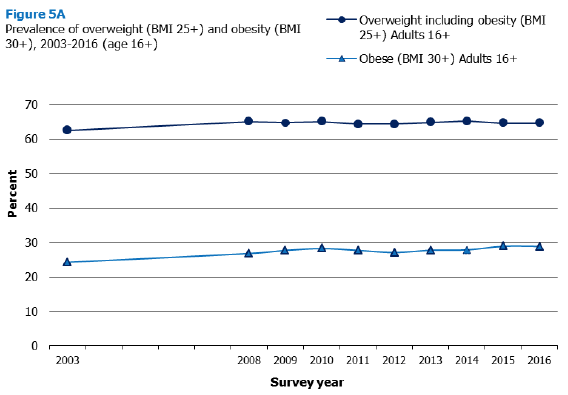
At 68% in 2016, the prevalence trend of overweight, including obesity among men in Scotland has followed the same pattern as all adults, see Figure 5B. Prevalence increased significantly from 65% in 2003 to 68% in 2008 and has since remained fairly unchanged, fluctuating between 67% and 69% during the period of 2008 to 2016.
Prevalence of overweight including obesity among women was 61% in 2016, continuing the stable trend which has remained between 60% and 62% during the 2003 to 2016 period.
As well as a slightly different pattern for men and women over time, Figure 5B shows men were significantly more likely than women to be overweight including obese across all years.
Figure 5B, Table 5.1
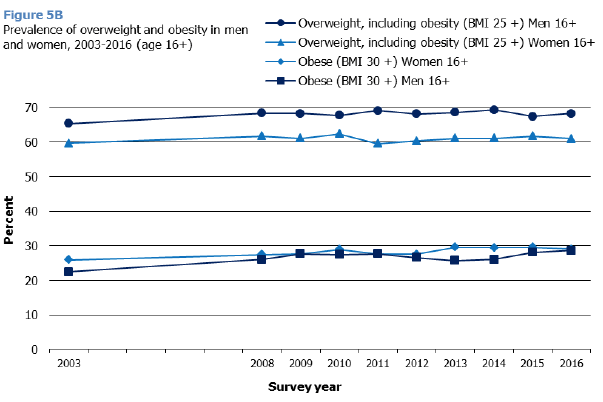
5.3.2 Trends in obesity prevalence since 2003
As shown in Figures 5A, levels of obesity, including morbid obesity, in adults increased from 24% to 27% between 2003 and 2008 and has since remained fairly static, fluctuating between 27% and 29% (29% in 2016). A similar pattern was observed among both men and women.
In 2016, prevalence of obesity in women was the same as that in men (29%). As shown in Figure 5B, there has been little difference between men and women in prevalence of obesity, including morbid obesity, since 2003.
Figure 5A, Figure 5B, Table 5.1
5.3.3 Trends in mean adult BMI since 2003
Adult mean BMI in 2016 was the highest since the start of the time series in 2003 (27.7 kg/m² compared with 27.1 kg/m²). There has been a general upward trend over these years and adult mean BMI has been in the ‘overweight’ category in all years since 2003.
In 2016, mean BMI for both men and women was the same (27.7 kg/m²). In line with trends seen in all adults, mean BMI in men and women has been steadily increasing most years since 2003, though the increase has been more significant amongst men (in 2003, mean BMI was 27.0 kg/m² for men and 27.2 kg/m² for women).
5.3.4 Adult BMI in 2016, by age and sex
As shown in Figures 5C and 5D, there was a clear association between age and BMI in 2016.
In 2016, overweight including obesity (BMI of 25 and over), prevalence for all adults was highest amongst those aged 65-74 (78%) and lowest amongst those aged 16-24 (40%). Overweight including obesity increased steadily with age until the 75 and over age group, where the percentage dropped significantly (from 78% of those aged 65 to 74, to 70% of those aged 75 and over).
Obesity (BMI of 30 and over) was also lowest amongst adults aged 16-24 (14%) and highest amongst those aged 65-74 (36%) with a significant drop amongst those aged 75 and over (27%).
The largest increase in obesity between contiguous age groups happened between the youngest age group (16-24) and those aged 25-34, where prevalence doubled from 14% to 28%.
Mean BMI was highest amongst adults aged 65-74, at 29.0 kg/m² (overweight), and lowest amongst adults aged between 16 and 24, at 24.8 kg/m² (healthy weight).
Prevalence of overweight including obesity (BMI of 25 and over) in men increased with age (41% of men aged 16-24, compared with 85% of men aged 65-74), and then decreased at ages 75 and over (70%).
A similar pattern was evident for prevalence of obesity (BMI of 30 and over) in men which also saw a steady increase with age (10% of men aged 16-24, compared with 41% of men aged 65-74), and a significant decrease at ages 75 and over (22%).
With women, prevalence of overweight including obesity (BMI of 25 and over) increased with age (39% of women aged 16-24, compared with 73% of women aged 65-74), with a small decrease among those aged 75 and over (70%). There was no consistent relationship between age and obesity among women, with prevalence fluctuating between 27% and 34% between the 25-34 and 75 and over age groups (see Figure 5D). However, women were significantly more likely than men to be obese in both the youngest age group (18% of women aged 16-24, compared with 10% of men) and the oldest age group (31% of women aged 75 and over, compared with 22% of men).
For both men and women, there was a general finding of BMI increasing with age, from lowest in those aged 16-24 (24.4 kg/m² in men and 25.1 kg/m² in women) to highest in those aged 65-74 (29.7 kg/m² in men and 28.4 kg/m² in women), before decreasing significantly in those aged 75 and over.
Figure 5C, Figure 5D, Table 5.2
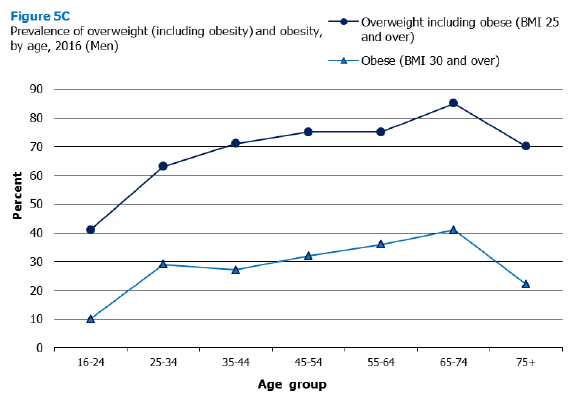
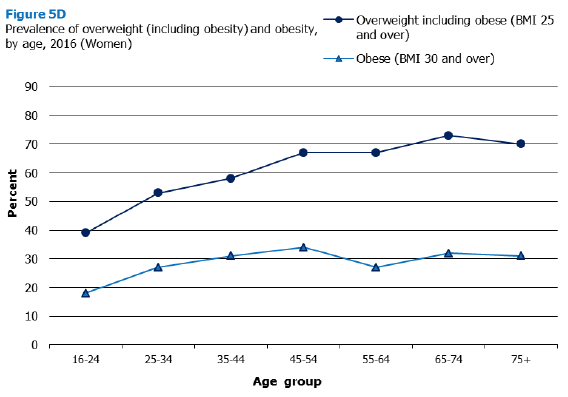
5.3.5 Adult BMI in 2016, by area deprivation
As shown in Figure 5E, overweight, including obesity, for all adults increased significantly with deprivation; from 56% of adults in the least deprived quintile, to 71% in the second most deprived quintile before decreasing to 65% in the most deprived quintile.
Obesity, including morbid obesity, also increased with deprivation. In the least deprived quintile, one fifth (20%) of adults were obese, compared with almost 36% in the second most deprived quintile. As with overweight, obesity prevalence then decreased again in the most deprived quintile (32%).
Mean BMI increased with deprivation, peaking at 28.5 kg/m² in the second most deprived quintile, compared with 26.5 kg/m² in the least deprived quintile.
Figure 5E, Table 5.3
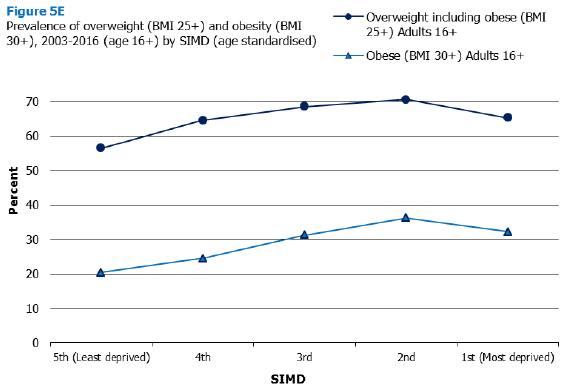
A similar pattern of association between BMI and deprivation was found for both men and women (as shown in Figures 5F and 5G); the association being more pronounced among women.
Both men and women in the least deprived areas in Scotland had the lowest prevalence of overweight including obesity (62% of men and 50% of women). For women, prevalence increased with deprivation, peaking in the third and second most deprived quintiles (67%). For men, prevalence was highest in the second most deprived quintile, at almost three quarters (74%).
Prevalence of obesity, including morbid obesity, in men increased significantly as area deprivation increased, peaking at 40% of men in the second most deprived quintile (compared with 20% in the least deprived quintile), before significantly decreasing in the most deprived quintile, to 29%.
Amongst women, prevalence of obesity, including morbid obesity, increased with deprivation (20% in the least deprived quintile compared with 35% in the most deprived quintile). Prevalence of obesity amongst men in the most deprived quintile was 6 percentage points lower among women in that quintile.
Figure 5F, Figure 5G, Table 5.3
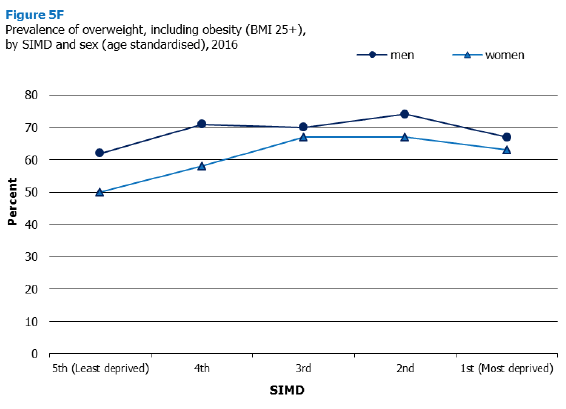
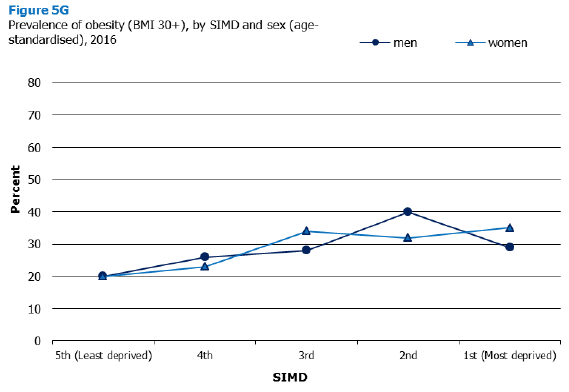
5.3.6 Adult BMI by consumption of foods and drinks high in sugar and/or fat for 2014-2016 combined
Although overall consumption of foods and drinks high in sugar and/or fat among adults appeared to be higher amongst those who were underweight or a normal weight and those who were overweight (75% and 74% respectively) than those who were obese (70%), this difference was not statistically significant. However, some patterns of association were found between BMI and specific types of food that are high in fat and/or sugar and how often they were consumed.
When considering just consumption of sweets or chocolates once a day or more, analysis showed this was significantly higher amongst those who were underweight or normal weight (31%) than those who were overweight (27%) or obese (25%).
Analysis of adult BMI by consumption of cakes twice a week or more showed that this was highest amongst those with an overweight BMI (37%), followed by adults who were underweight or a normal weight (33%). Adults who were obese were the least likely to consume cakes twice a week or more (29%).
When exploring the relationship between BMI and consumption of non-diet soft drinks, analysis showed that the pattern differed for men and women. Consumption of non-diet soft drinks once a day or more was, for men, highest amongst those who were underweight or a normal weight (32%, compared with 24% of obese men, and 23% of overweight men). For women, however, consumption was highest amongst those who were obese (24% compared with 20% of underweight or normal weight women and 18% of obese women).
There was no significant association between BMI and consumption of biscuits once a day or more, or eating ice cream once a week or more.
For further analysis on the consumption of foods and drinks high in sugar and/or fat by sex, please refer to Chapter 4.
5.4 Child Overweight And Obesity Prevalence
5.4.1 Trends in child healthy weight, overweight and obesity prevalence since 1998
A child is described as being of a ‘healthy weight’ if their BMI is above the 2nd percentile and below the 85th percentile of the UK 1990 reference curves.
In 2016 the prevalence of children aged between 2 and 15 in the healthy weight range was 70%. Trends in children who are a healthy weight have remained fairly stable since 1998, with the lowest prevalence occurring in 2011 (65%) and the highest in 2015 (72%).
Following the trend for all children, healthy weight prevalence amongst both boys and girls has remained relatively steady since 1998.
The prevalence of healthy weight in boys had been on the rise since 2011, falling only in 2016 to 70% (down from 73% in 2015).
Prevalence of those at risk of overweight, including obesity in children has remained relatively stable between 1998 (29%) and 2016 (29%), fluctuating between 28% and 33% in the intervening years.
Although the prevalence of children at risk of obesity is the same in 2016 (14%) as in 1998, prevalence had been stable from 2003 to 2014 (fluctuating between 16% and 17%) but has been steadily decreasing since 2014, going down from 17% in 2014, to 15% in 2015, and dropping further to 14% in 2016. This is an indication of a downward trend; however data for subsequent years will be required to confirm this.
In 2016, 28% of boys and 29% of girls aged between 2 and 16 were at risk of overweight, including obesity. As shown in Figure 5H, there is no clear pattern in prevalence of risk of overweight for either boys or girls, with fluctuation in previous survey years (between 38% and 26% for boys and 34% and 27% for girls).
Figure 5H, Table 5.5
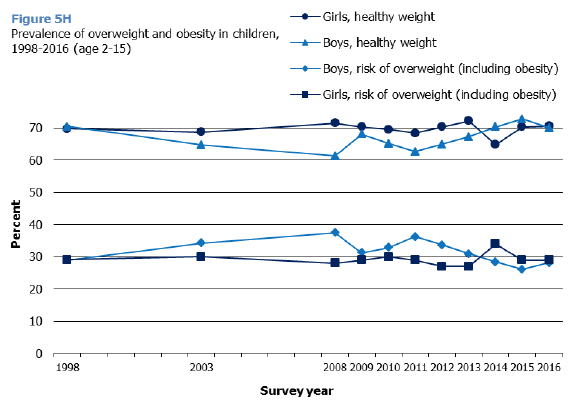
There has been little difference in rates of risk of obesity between boys and girls between 1998 and 2016. However, for boys there has been a decline in prevalence of risk of obesity since 2012 (20% in 2012 compared with 14% in 2016).
5.4.2 Child BMI categories by area deprivation for 2015/2016 combined
In 2015/2016, prevalence of children in the healthy weight range was significantly associated with area deprivation; however the pattern did not follow a clear gradient. The highest healthy weight prevalence was found among the least deprived quintile (75%), whilst it was lowest in the second most deprived quintile (66%).
A clear gradient was evident for boys; as shown in Figure 5I, boys in the least deprived quintile were the most likely to be in the healthy weight range (78%), compared with 63% of boys in the most deprived quintile.
The pattern was different for girls, as shown in Figure 5I. Girls in the two least deprived quintiles had the highest prevalence in the healthy weight range (72%) and the lowest prevalence was the second most deprived (65%) however this difference was not statistically significant.
As shown in Figure 5J, prevalence of risk of overweight including obesity, was significantly associated with area deprivation; it was highest in the second most and most deprived quintiles (33% and 32% respectively) and lower in the less deprived quintiles (ranging between 25% and 26%).
For boys, prevalence of risk of overweight including obesity was lowest in the least deprived quintile (21%) and highest in the most deprived quintile (35%).
Following a different pattern, girls in the second most deprived quintile were at highest risk of overweight including obesity (34%) compared with the other four quintiles where prevalence ranged between 28% and 29%.
Prevalence of children at risk of obesity was not significantly associated with area deprivation.
Figure 5I, Figure 5J, Table 5.6
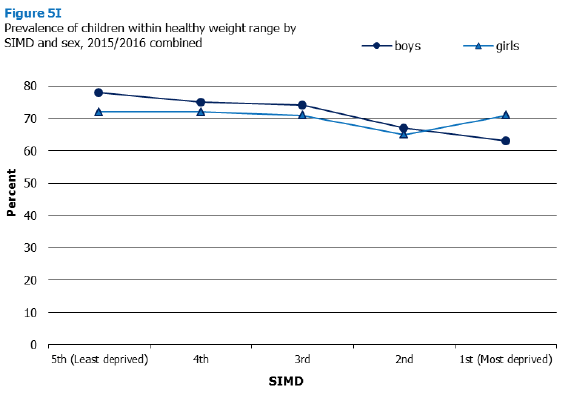
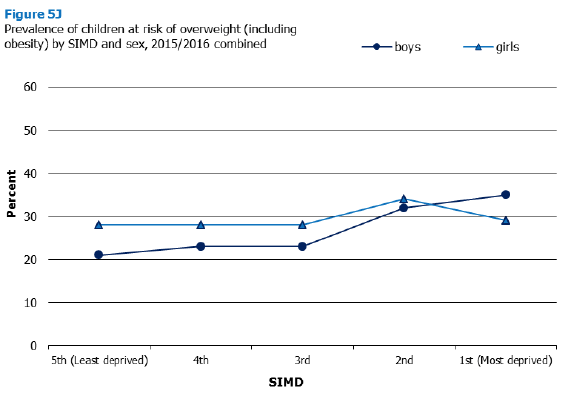
Contact
Email: Julie Landsberg, Julie Landsberg
Phone: 0300 244 4000 – Central Enquiry Unit
The Scottish Government
St Andrew's House
Regent Road
Edinburgh
EH1 3DG
There is a problem
Thanks for your feedback
